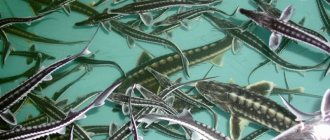Five pairs of eyes, three jaws and two hundred and seventy teeth... A predator weighing from one gram and about twelve centimeters long, feeds on blood and replaces medicine... The medical leech is the most common species for breeding out of the five hundred existing in nature. And the only one useful for humans. Only a few farms breed medicinal leeches. However, at home you can also achieve the reproduction of these worms.
Natural healers
During hirudotherapy, leeches adhere to the body and suck blood. But the therapeutic effect does not lie in this process at all. What matters is not what leeches suck, but what they give. Hirudin is a unique enzyme that is contained in the saliva secretion of a medicinal leech. Through bites, this substance enters the human body, providing healing properties. In general, the leech produces sixty-four types of amino acids and forty types of enzymes that are beneficial to humans.
Experts managed to remove hirudin artificially, but it only works for three days, while the natural one is effective for three months. Hirudin and other enzymes of leeches have anti-inflammatory, analgesic, immunostimulating effects, and also normalize lipid metabolism in the human body.
Hirudotherapy is used to treat diseases of the endocrine and digestive systems, gynecological ailments, diseases of the joints and respiratory organs.
Leeches are a natural medicine without side effects. Their size does not matter; all individuals are useful and safe. Doctors usually prescribe nine sessions of hirudotherapy every six months. The interval between sessions should be three to four days.
Having sucked, the leech increases in size up to ten times. An individual weighing from one to three grams can suck about fifteen milliliters of blood.
What are leeches
You might be surprised to learn that leeches belong to the class of worms. By the way, you can find out how to organize a business using the same natural fertilizer and worm breeding that we mentioned at the very beginning of the article by following the links.
Leeches feed on blood, in fact, this is how they treat – by sucking out “bad” blood and introducing various enzymes and substances into the human body that have pronounced anti-inflammatory and analgesic properties. There are about 500 different types of leeches known on the planet; in our country there are only 62 of them. However, from the point of view of organizing a business, we are only interested in the type - the medical leech.
Breeding leeches on special farms
In Russia there are hardly a dozen centers for growing medicinal leeches that operate legally. Their capabilities do not cover even 50% of the demand of hirudotherapists. A large farm for breeding leeches operates, for example, in the Moscow region. There is a large biofactory in the Saratov region.
Breeding of natural healers is carried out under the supervision of specialists - “leech breeders”. They monitor the process, create comfortable conditions for breeding and growth of offspring.
On farms, leeches live in ordinary three-liter glass jars of 200-300 pieces. The vessels are stored in rooms protected from sunlight and any odors. Medicinal leeches cannot tolerate aromas either during growth or during treatment.
Some individuals go to breeding stock. Leeches are hermaphrodites, in even numbers up to 16-18 they are placed in jars for reproduction. After fertilization, light rings appear on the body of leeches. After two weeks, the queens are placed in peat. Here they release their foam, forming a cocoon that will take about three months to mature.
The largest individuals are selected for reproduction. They are raised for almost two years and fattened to a weight that is five times the weight of a normal commercial specimen.
When the babies crawl out of the cocoon, they are fed for about five months. Then - three months of hunger strike, so that the individuals are ready to perform their medicinal function for sale.
In general, breeding medicinal leeches is an artificial cultivation, which sometimes requires introducing brethren from the wild. Because with each generation, farm leeches become weaker and smaller.
Before leeches are shipped to orders, they undergo a medical examination and activity test. A leech is considered good if it is ready to attach itself.
Business on leeches
Breeding medicinal leeches as a business is a good option for generating income without major investments. You must register as an individual entrepreneur or legal entity. But the process of obtaining the necessary license from the Federal Service for Surveillance in Healthcare will bring more trouble. A leech is considered a medical product, so its cultivation requires special documents.
A starting batch of leeches can be ordered from specialized farms. The selling price is usually from thirty rubles per individual.
If, when planning a business, you decide to save money and catch leeches in a pond, then most likely you will spend more than you receive income. Water leeches are not suitable for hirudotherapy.
It is recommended to start a leech breeding business with 500-600 individuals. When purchasing leeches in smaller quantities, profitability is questionable.
Large organic farms can raise seven to eight million leeches per year.
Where can I get leeches for breeding?
The easiest way is to catch leeches in a clean natural reservoir. Understanding and accepting full responsibility for your actions, which can result in both large administrative fines and very real criminal penalties. After all, the consequences of using wild leeches on people can be the most unpredictable.
So there is only one option left - purchasing individuals from registered leech farms, where for your purchase you will be given all the necessary documents confirming the possibility of using the purchased leeches for medical purposes.
Conditions for growing leeches
In the private business of growing leeches, the same conditions must be provided as on farms. For each stage of development of the individual you will need separate containers:
- Cocoon maturation in boxes with peat.
- Growing fry in glass jars or plastic containers.
- Aquariums, jars or containers for holding adult worms.
It is important to monitor the water in the vessels where the leeches are placed. In order not to miss the moment of contamination or mucus formation, it is better to use aquariums or glass jars. Some grow individuals in food-grade plastic buckets. Also an acceptable option, but transparent glass vessels are preferable. Jars or buckets should be covered with a piece of cloth or a perforated lid.
Without maintaining a certain state of water and microclimate in the room, leeches may die. Air humidity should be at least eighty to eighty-five percent, water and air temperature should be twenty-four to twenty-seven degrees.
The water in any containers where leeches live must be changed at least twice a week. Aerobic filters will be required to circulate the water.
You need to feed leeches once a month. They feed on bovine blood.
Leech breeding technology
Under artificial conditions they are kept in aquariums or ordinary three-liter jars with purified water. The container must be covered from above so that the “tenants” do not escape.
You will need a room with several rooms or sectors (total area - from 30-35 square meters ) and shelves for aquariums and jars.
You can set up such a farm at home. It is important to ensure that at all stages of growth and development the creatures are kept separately from younger or older individuals. For example, fry are placed with fry, and adults live together.
How to deliver leeches to the customer
If the distance to the customer is no more than one hundred kilometers, then leeches can be delivered in plastic containers covered with a perforated lid. For each three-liter container - two hundred leeches.
If the distance is more than a hundred kilometers, then it is more convenient to use fabric bags. To make them, it is better to use calico; the size of one bag is thirty by twenty centimeters. The bag can accommodate up to three hundred leeches.
The bag should be damp. You can tie it with a regular rubber band and wrap it in wrapping paper. It is better to transport bags in cardboard boxes. In such conditions, leeches will survive a two-day journey.
Keep in mind that leeches are very sensitive to changes in microclimate. At the slightest deviation from the conditions of detention or transportation, they may die.
No special machinery or equipment is used in the process of raising individuals. All transplanting and catching work must be done manually.
Conditions for keeping leeches
These are not very demanding creatures, but if the liquid is contaminated or one gets sick, the entire population can die. Therefore, it is better to keep them in small groups: 20-40 in one container.
Climatic conditions
The main condition is clean water . You will need to purchase at least good household filters to clean it. The reservoir is filled halfway with liquid.
It is necessary to change the water every day and at the same time clean the container from accumulated mucus. Make sure there are no impurities in the liquid (for example, chlorine).
Other conditions for keeping leeches
- Temperature – +25-27 degrees;
- Air humidity – from 80%.
Periodically add sand to the jars so that the parasites can clear out the mucus.
Breeding at home
Breeding leeches at home may seem labor-intensive for beginners. However, if you strictly follow the recommendations, then caring for pets will no longer be troublesome.
After delivery, place the leeches in a food-grade plastic container half filled with water. The water can be tap water, but allowed to stand for about two days so that the chlorine is removed. Typically, leeches tolerate transportation well if it is organized correctly. But sometimes there may be a sick individual in the batch. Recognizing it is quite simple: a non-viable leech will be almost motionless in the center of the container.
Once you are sure that only medicinal leeches remain, transfer them to a jar of water. Cover the container with a napkin. Work only with clean rubber gloves. Active leeches will contract in the muscles if you lightly squeeze the specimens in your palm.
The most important…
More responsible actions are feeding and breeding. If we assume that the cultivation of leeches is carried out strictly officially, then first of all the inspection commissions will be concerned with the question of where the blood is taken for this purpose. For a small home complex, you can buy blood clots on the market. Some farmers sell them to make rare sausage. Larger production will require ordering blood from the slaughterhouse. At the same time, legal production requires not only compliance with sanitation rules, but also strict documentation.
Private practitioners recommend this method. The blood clot is wrapped in adhesive film, which is used in stores for packaging meat or fish, and suspended in a container with leeches. This method is suitable for feeding young and mature individuals. This is done once every 2-3 months. Before delivery of medicinal leeches to retail distributors begins, they must fast for approximately the same period.
Reproduction of leeches is a more complicated matter. For mating and the copulation process, you need to prepare peat, check it for the possible presence of foreign impurities, and then fill it with infused dechlorinated water. It is important to keep the proportions correctly. If the mixture turns out to be too liquid or too dry, the leeches will not be able to make the moves needed to lay cocoons. Semi-adult leeches of similar size, which have already been fed 3-4 times, are placed in jars with water in pairs. They wrap around each other, stick together and the process of fertilization begins. Mating can last about a month. Leeches do not have females directly, but in a pair one of them will play her role.
Then they are transplanted into jars with diluted peat to the desired consistency. After a certain number of days, it will be possible to find cocoons in it, which in their structure are similar to foam rubber, and are somewhat smaller in size than a quail egg. Cocoons can be found inside passages made in peat and even on its surface. When examining them in the light, small leeches that are located inside the nutrient will become noticeable.
Newborn leeches appear in the jar after about thirty days. Each cocoon produces from 10 to 15 filaments, as young growth is commonly called. At the same time, some inheritance is lost from time to time.
More to read:
How to grow microgreens at home and make money?
How to open a dog and cat grooming salon?
How to open a home guinea fowl farm?
What to feed leeches at home
Nothing. The only good thing will be from hungry leeches. They can live on a hunger strike for six to twelve months. During this time, they are usually already used in therapy. Therefore, do not worry about the nutrition of worms, and do not listen to ridiculous advice about the need to sweeten the leeches’ habitat with sugar. They don't grow thin.
But it’s worth monitoring the microclimate in the room. Room temperature should be maintained; jars of leeches are best stored in a shady room. The water must be changed every three to five days, well filtered and sufficiently saturated with oxygen. Do not be alarmed if the water becomes cloudy - this is the result of the release of waste products from leeches.
Breeding leeches at home as a business
Medical leeches come in small, medium and large sizes. Breeding leeches at home begins with ordering large individuals that can bear offspring. As soon as you receive a delivery with a batch of leeches, feed them. Then place the individuals in the jars in pairs, with no more than 18 worms per jar. After a month, light rings should appear on the leeches - a sign of fertilization. Soon they need to be moved to peat.
In peat, leeches lay a cocoon in which from fifteen to twenty fry mature. From one hundred queen leeches you can get one thousand to two thousand individuals.
If you do not intend to grow leeches for sale, but want to use them for your treatment, then it would be correct to consult a doctor before starting therapy.
Sales channels
Based on where the leech is used, you can look for appropriate distribution channels. It can be:
- Beginner leech farmers who need a starting purchase of individuals.
- Private medical specialists who specialize in hirudotherapy.
- Pharmacies.
- Medical centers that offer hirudotherapy services.
- Deliveries to other countries.
If we talk about Russia, the cost of one leech ranges from 30 to 40 rubles, while when selling it abroad you can earn up to 400 rubles. From the sale of 500 thousand leeches you can earn about a million dollars. In general, at the start, a legal business will require an investment of 15-20 million rubles, but it will pay off within five years.











